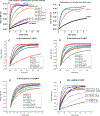Effect of Phosphate and Ferritin Subunit Composition on the Kinetics, Structure, and Reactivity of the Iron Core in Human Homo- and Heteropolymer Ferritins
- PMID: 36099002
- PMCID: PMC9548343
- DOI: 10.1021/acs.biochem.2c00354
Effect of Phosphate and Ferritin Subunit Composition on the Kinetics, Structure, and Reactivity of the Iron Core in Human Homo- and Heteropolymer Ferritins
Abstract
Ferritins are highly conserved supramolecular protein nanostructures that play a key role in iron homeostasis. Thousands of iron atoms can be stored inside their hollow cavity as a hydrated ferric oxyhydroxide mineral. Although phosphate associates with the ferritin iron nanoparticles, the effect of physiological concentrations on the kinetics, structure, and reactivity of ferritin iron cores has not yet been explored. Here, the iron loading and mobilization kinetics were studied in the presence of 1-10 mM phosphate using homopolymer and heteropolymer ferritins having different H to L subunit ratios. In the absence of ferritin, phosphate enhances the rate of ferrous ion oxidation and forms large and soluble polymeric Fe(III)-phosphate species. In the presence of phosphate, Fe(II) oxidation and core formation in ferritin is significantly accelerated with oxidation rates several-fold higher than with phosphate alone. High-angle annular dark-field scanning transmission electron microscopy measurements revealed a strong phosphate effect on both the size and morphology of the iron mineral in H-rich (but not L-rich) ferritins. While iron nanoparticles in L-rich ferritins have spherical shape in the absence and presence of phosphate, iron nanoparticles in H-rich ferritins change from irregular shapes in the absence of phosphate to spherical particles in the presence of phosphate with larger size distribution and smaller particle size. In the presence of phosphate, the kinetics of iron-reductive mobilization from ferritin releases twice as much iron than in its absence. Altogether, our results demonstrate an important role for phosphate, and the ferritin H and L subunit composition toward the kinetics of iron oxidation and removal from ferritin, as well as the structure and reactivity of the iron mineral, and may have an important implication on ferritin iron management in vivo.
Conflict of interest statement
The authors declare no competing financial interest.
Figures






Similar articles
-
Iron Oxidation and Core Formation in Recombinant Heteropolymeric Human Ferritins.Biochemistry. 2017 Aug 1;56(30):3900-3912. doi: 10.1021/acs.biochem.7b00024. Epub 2017 Jul 18. Biochemistry. 2017. PMID: 28636371 Free PMC article.
-
Impact of Phosphate on Iron Mineralization and Mobilization in Nonheme Bacterioferritin B from Mycobacterium tuberculosis.Inorg Chem. 2020 Jan 6;59(1):629-641. doi: 10.1021/acs.inorgchem.9b02894. Epub 2019 Dec 10. Inorg Chem. 2020. PMID: 31820939
-
The ferroxidase center is essential for ferritin iron loading in the presence of phosphate and minimizes side reactions that form Fe(III)-phosphate colloids.Biometals. 2012 Apr;25(2):259-73. doi: 10.1007/s10534-011-9500-z. Epub 2011 Oct 20. Biometals. 2012. PMID: 22012445
-
Reductive Mobilization of Iron from Intact Ferritin: Mechanisms and Physiological Implication.Pharmaceuticals (Basel). 2018 Nov 5;11(4):120. doi: 10.3390/ph11040120. Pharmaceuticals (Basel). 2018. PMID: 30400623 Free PMC article. Review.
-
Iron mineralization and core dissociation in mammalian homopolymeric H-ferritin: Current understanding and future perspectives.Biochim Biophys Acta Gen Subj. 2020 Nov;1864(11):129700. doi: 10.1016/j.bbagen.2020.129700. Epub 2020 Aug 14. Biochim Biophys Acta Gen Subj. 2020. PMID: 32798636 Review.
Cited by
-
Hyperthermostable recombinant human heteropolymer ferritin derived from a novel plasmid design.Protein Sci. 2023 Jan;32(1):e4543. doi: 10.1002/pro.4543. Protein Sci. 2023. PMID: 36519270 Free PMC article.
-
Quantum Magnetism of the Iron Core in Ferritin Proteins-A Re-Evaluation of the Giant-Spin Model.Molecules. 2024 May 11;29(10):2254. doi: 10.3390/molecules29102254. Molecules. 2024. PMID: 38792115 Free PMC article.
-
Ferritin microheterogeneity, subunit composition, functional, and physiological implications.Sci Rep. 2023 Nov 14;13(1):19862. doi: 10.1038/s41598-023-46880-9. Sci Rep. 2023. PMID: 37963965 Free PMC article.
-
Ferritin nanocages as efficient nanocarriers and promising platforms for COVID-19 and other vaccines development.Biochim Biophys Acta Gen Subj. 2023 Mar;1867(3):130288. doi: 10.1016/j.bbagen.2022.130288. Epub 2022 Dec 5. Biochim Biophys Acta Gen Subj. 2023. PMID: 36470367 Free PMC article. Review.
References
-
- Bou-Abdallah F The Iron Redox and Hydrolysis Chemistry of the Ferritins. Biochim. Biophys. Acta 2010, 1800, 719–731. - PubMed
-
- Ford GC; Harrison PM; Rice DW; Smith JM; Treffry A; White JL; Yariv J Ferritin: Design and Formation of an Iron-Storage Molecule. Philos. Trans. R. Soc. London, Ser. B 1984, 304, 551–565. - PubMed
-
- Harrison PM; Andrews SC; Artymiuk PJ; Ford GC; Guest JR; Hirzmann J; Lawson DM; Livingstone JC; Smith JMA; Treffry A; Yewdall SJ Probing Structure-Function Relations In Ferritin And Bacterioferritin. Adv. Inorg. Chem. 1991, 36, 449–486.
-
- Melman A; Bou-Abdallah F Iron Mineralization and Core Dissociation in Mammalian Homopolymeric H-Ferritin: Current Understanding and Future Perspectives. Biochim. Biophys. Acta 2020, 1864, 129700. - PubMed
Publication types
MeSH terms
Substances
Grants and funding
LinkOut - more resources
Full Text Sources
Medical

